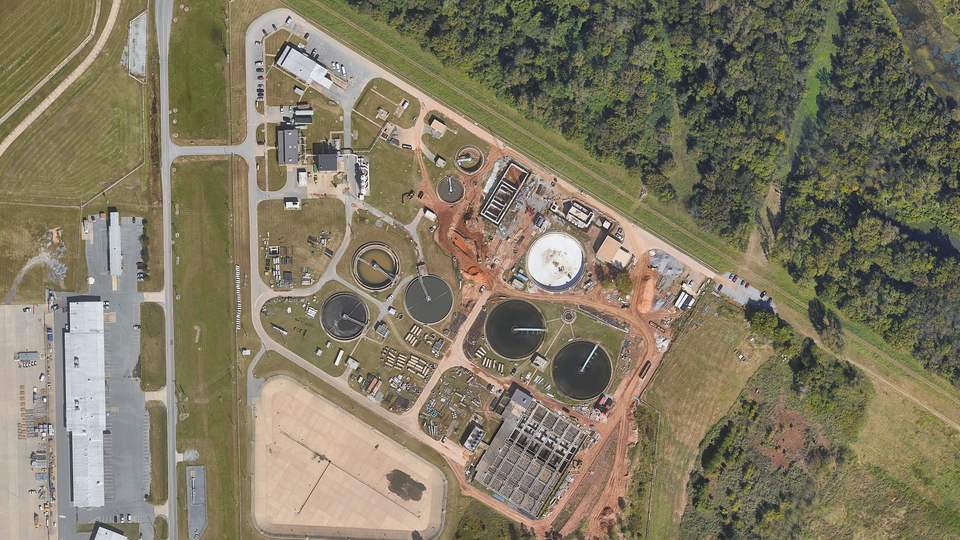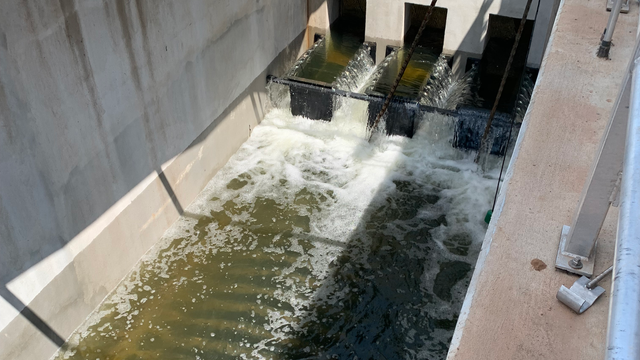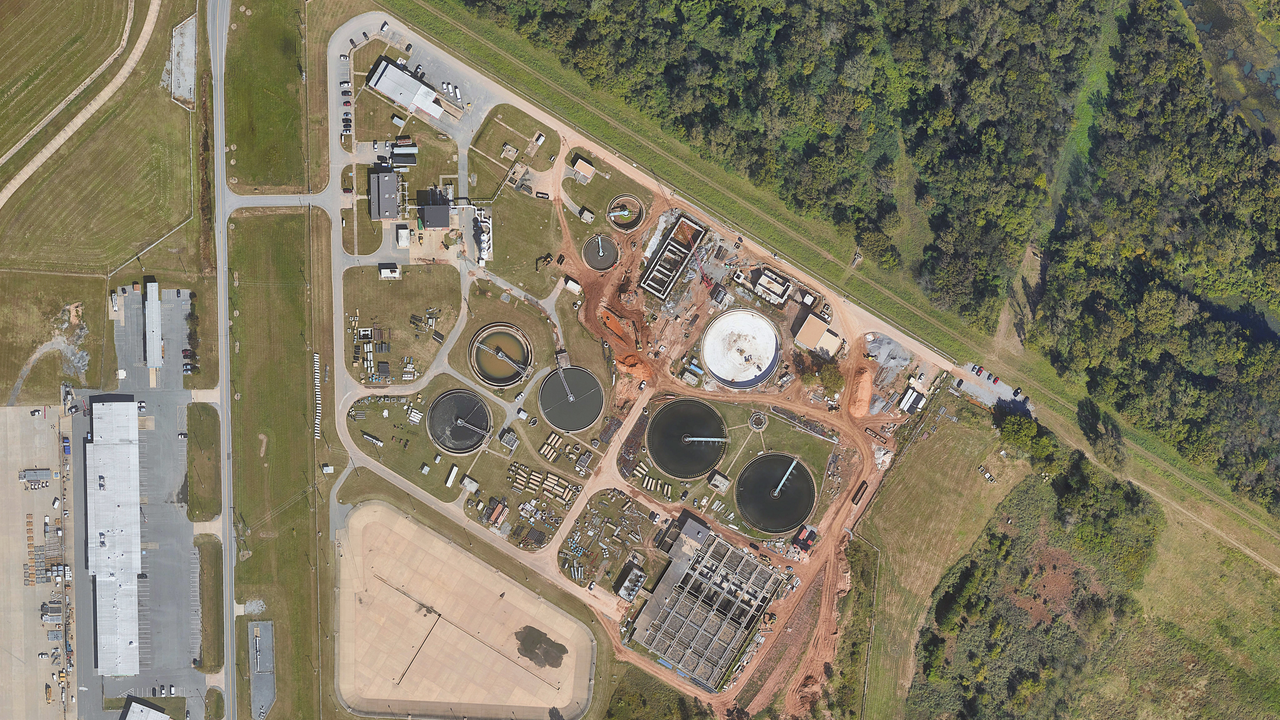Auxiliary Treatment for Performance Resiliency

- Project Name
- Adams Field WRF Resiliency Upgrade
- Location
- Little Rock, Arkansas
- Client
- Little Rock Water Reclamation Authority
Leveraging a regulatory change and technology advancements, Little Rock Water Reclamation Authority (LRWRA) implemented a dual-purpose auxiliary treatment solution pioneered by Black & Veatch in collaboration with Hawkins-Weir Engineers (HW). The innovative strategy strengthened the resilience of the Adams Field Water Reclamation Facility (WRF), enabling it to handle peak wet weather flows cost-effectively while also producing reuse-quality effluent during non-wet weather conditions. The project won the ACEC Arkansas 2023 Engineering Excellence Award in the Water and Wastewater category.
ㅤ
The Opportunity
In 2013, a regulatory change occurred that reaffirmed the permitting of wet weather blending practices.
Blending is a well-established approach to mitigating peak wet weather flows at WRFs. Inflow and infiltration commonly cause significantly higher wastewater flow rates during peak wet weather events. This significantly alters WRF influent characteristics, creating havoc for the microorganisms that do much of the work in biological treatment processes. Blending mitigates the issue by splitting a portion of peak flows for treatment through clarification and disinfection processes in parallel with the portion of peak flows treated through biological processes. This helps stabilize the overall treatment process while still meeting regulatory standards for secondary treatment and receiving stream water quality requirements.
Leveraging the opportunity created by this regulatory change, LRWRA moved forward with development of a new wet weather treatment system to support 61-million-gallon in-system storage facilities that had been recently constructed for the Adams Field WRF.
ㅤ
The Concept
The team first helped LRWRA successfully modify its NPDES permit. The Arkansas Department of Energy and Environment’s Division of Environmental Quality authorized the modification with no objections from EPA. It allowed LRWRA to modify the Adams Field WRF, to increase its peak discharge from 72 million gallons a day (MGD) to 94 MGD. It also reduced the planned storage volume by 34 million gallons. These changes resulted in an immediate savings of more than $10 million for LRWRA as a result of multiple collection system storage/equalization projects that were downsized or cancelled due to the opportunity to push more flow through the WRF.
Enabling the modification was an improved approach to wet-weather treatment at Adams Field and an improvement in applicable technologies. The improvement: dual-purpose auxiliary or parallel treatment with high-rate filtration technology.
LRWRA’s modified permit became the first in Arkansas and first in EPA Region 6 to recognize dual-purpose filtration as an acceptable treatment method.
LRWRA selected a Black & Veatch / HW team to develop, design and provide construction phase engineering services for the facility expansion and upgrades. During peak wet-weather flows, the new auxiliary treatment process train operates in parallel with the activated sludge treatment process train. The new auxiliary treatment process was designed to use high-rate filtration technology to capture solids from peak flows and transfer them to the activated sludge treatment process. The auxiliary treatment facilities not only add peak flow capacity, but also provide a higher level of process stability. Furthermore, the filtration facility is also used during dry weather to improve effluent quality and improve disinfection performance year-round. This dual purpose during both dry and wet weather provides a greater return on the investment and makes the WRF more resilient in its capacity and effectiveness.
ㅤ
The Solution
LRWRA’s auxiliary solution added 58 MGD of dual-purpose filtration capacity, increased UV disinfection capacity to 94 MGD, added a 94-MGD effluent pump station, and retrofitted 36 MGD of activated sludge upgrades including aeration basin and secondary clarifier conversions to meet new ammonia limits and support potential nutrient limits in the future.
One of its key innovations was its use of the latest generation (and at the time among the largest-scale installations anywhere) of pile-cloth disk filtration, an enhanced high-rate treatment (EHRT) technology that does not require chemicals. Specifically, the project was one of the first installations worldwide of the Aqua-Aerobics’ AquaStorm™ MegaDisk® filtration process. Black & Veatch introduced it to LRWRA operators and engineers and advised the team during the review process. LRWRA selected this technology after a comprehensive evaluation of EHRT technology alternatives, including triple-bottom-line assessments, onsite side-by-side piloting, peer interviews at reference full-scale installations, and visits to Aqua-Aerobics’ Research and Technology Center and manufacturing headquarters.
The project also incorporated the McKinney Feedwell Floor Baffle system as part of rehabilitation and conversion of the secondary clarifiers in the activated sludge treatment process train. Conceived and physically modeled in the 1970s by Dr. Ross McKinney and researchers at the University of Kansas, the system began to be used in the United States circa 2010 after successful full-scale operations in the UK and Germany. This simple yet elegant feedwell design optimizes the settling and thickening performance of secondary clarifiers like those at the Adams Field WRF and stabilizes their performance during peak flows and loads.
ㅤ
Other project features include:
A step-feed biological nutrient removal (BNR) process designed to comply with Adams Field WRF’s new ammonia limits while conserving limited influent alkalinity and minimizing aeration energy demands.
New multi-stage blowers for low-pressure diffused aeration and compressors for high-pressure mixing air.
Aeration basin modifications with large-bubble compressed air mixing systems to create anoxic zones and new fine bubble aeration for the aerobic zones for energy-efficient oxidation and mixing.
A new return activated sludge pump station.
A new dual primary electrical feed with an automatic transfer switch to provide emergency backup power at a fraction of the cost of stand-by generators.
The dual-purpose, enhanced high-rate treatment (EHRT) and additional features included in the auxiliary system designed by the Black & Veatch / HW team significantly increased the performance resiliency of the Adams Field WRF. They provide cost-effective treatment of peak wet weather flows and limit the impact of high peaking factors on biological treatment processes while polishing normal dry-weather effluent to further improve the efficacy of the facility’s UV disinfection system and support future opportunities for water reuse by the nearby airport and industries.


Contact Us
Looking for a partner in innovation?
Let's Talk
